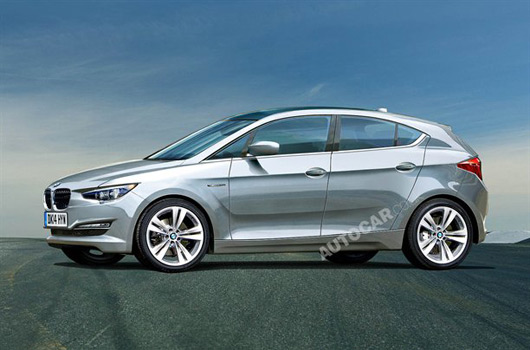
You’re looking at Autocar‘s rendering for the BMW 1 Series GT, or Compact Sports Tourer as it may be called. It’s biggest claim to fame is that it will be the first ever front-wheel drive BMW. It’s expected we’ll get our first official look at the car at the Paris Motor Show in September.
Incidentally, the same show will see the debut of the all-new Golf VII, one of the models the front-wheel drive BMW will be hoping to steal sales from.
Part of the reason for BMW to go against their proud rear-wheel drive tradition is to try and increase their annual sales to around two million per year. In 2011 they sold 1.6 million vehicles around the world. They believe this number is key to them remaining independent.
The trick to reaching that goal is to increase product while reducing costs. That’s why the 1 Series GT and the new F56 MINI will share so many components. And it’s also why we’ll no longer see a centrally mounted speedo on the next MINI.
BMW has platform shared before, with its 760Li and Rolls-Royce Ghost. In order to maintain as much individuality as possible most of the shared parts were under the skin, allowing each model to retain, visually at least, their key brand identity. BMW will take much the same approach with the front-wheel drive 1er and the MINI.
We’ve been critical of what we’ve termed as BMW’s dilution of the MINI brand as more and more BMW components creep in. So is BMW selling out, or doing what needs to be done to remain viable. That question has been asked and analysed by MotoringFile.
It’s certainly worth reading what MotoringFile has to say. Here’s a few snippets:
Seems like a simple concept—sell more. But it’s not. The three prongs of the BMW Group are all in the “premium†area within their segment. That means buyers tend to be more particular; materials need to be of high quality, electronics have to be the latest and greatest all while producing vehicles that are of the highest level of safety and efficiency… The solution is to offer more niche vehicles and broaden the appeal to more consumers while staying true enough to the brand’s reputation and heritage. For MINI that means products like the Coupe and Roadster on one hand and the Clubman and forthcoming Countryman Coupe on the other.
Having seen both the “F†generation MINI and the front wheel drive BMW test mules in person, I can fully attest to the outward differences. There is little in the way of shared design. If it wasn’t for the fact they are being announced as related their appearance would never lead to that conclusion…
Talking with engineers familiar with the dynamics of each car and how they perform I was told that each has an individual personality- much like siblings. The appearance and drive are directly related to the target market of each and there is little overlap… One source says that road feel is more in line with the R50 MINI while efficiency and comfort are more in line with the newer F20 1 Series. If that is even partially correct these cars will be a resounding success.
The theory sounds good. Let’s hope the practice remains true the individual BMW and MINI brands.
[Source: Autocar & MotoringFile]